Northern cardinals, Blue jays, American robins, and house sparrows. When someone says the word bird you may picture those and others you see in your neighborhood. But, what about the different types of big birds you may not see every day? Birds that weigh close to a hundred pounds or even hundreds of pounds. They’re out there! What about the largest bird of prey? Out of the many birds of prey, which one do you think is the largest?
Check out ten types of large birds ranked by their body weight. Some of these birds have additional features such as tremendous height or a large wingspan that make them a must-have on any list of large birds.
#10 Dalmatian Pelican

A
Dalmatian
Pelican (Pelecanus crispus) on the surface of Kerkini lake, northern Greece
©Georgios Alexandris/Shutterstock.com
Adult Dalmatian pelicans are from China and can weigh up to 30 pounds. Though their large bodies give them an unwieldy walk while onshore, they definitely qualify as big birds that fly. They’ve been observed flying at an altitude of 10,000 feet and higher.
Dalmatian pelicans have grayish/white feathers with black-tipped wings. They hold the title of the largest of all types of pelicans. Besides its size, the most notable thing about this pelican is its bright orange pouch. These monogamous pelicans are expert swimmers and hunters eating up to three pounds of fish every day.
#9 Andean Condor
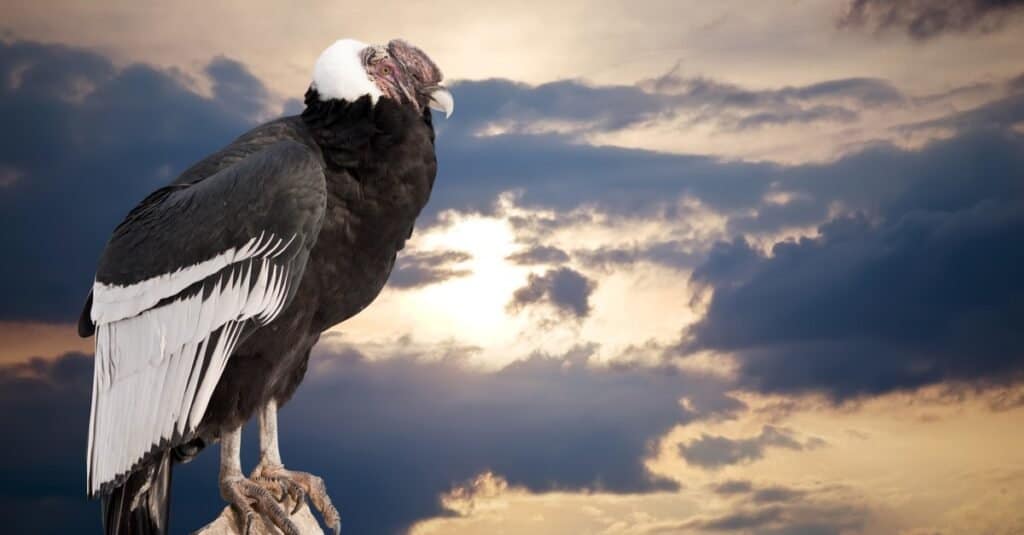
©BearFotos/Shutterstock.com
Andean condors make their home in the Andean mountains of South America. It’s considered the largest bird of prey by many scientists. Adult Andean condors can weigh as much as 33 pounds. This bird is easy to recognize with its black wings tipped with white feathers. Its long, curved beak and the white ring of feathers around its neck make these condors stand out in any collection of big birds that fly.
One of the many amazing facts about the largest bird of prey concerns its head. Though it has a bald, red head, the color of its head can become darker as a result of its changing emotions. Anger and fear can make this bird’s red skin become a deeper shade of red. This is similar to what happens to a person’s cheeks when he or she gets embarrassed. The person’s cheeks may turn red for a short period as an emotional reaction to the situation.
In addition to having a large body, these birds of prey have a wingspan of up to 11 feet! No wonder this bird is the national symbol of Chile, Colombia, Ecuador, Peru, and Bolivia. Their wingspan makes it easy to soar through the mountains in search of their preferred diet of dead cattle and other carrion.
#8 King Penguin

.
©fieldwork/Shutterstock.com
No list highlighting the different types of large birds is complete without a penguin or two. A male king penguin can weigh 40 pounds while females weigh a little less. Have you ever seen a video of penguins hopping along on rocky shorelines looking for fish? Well, with a body weighing 40 pounds, king penguins leave the hopping to smaller types of penguins. They prefer to walk at a slow pace along the beaches of Antarctica.
Some types of large birds have coloration that makes them stand out in a crowd. King penguins are included in that group. They have a familiar white chest paired with a black back and head. In addition, they have orange feathers in a tear shape on each side of their head. This orange coloration spills down below their chin.
#7 Kori Bustard
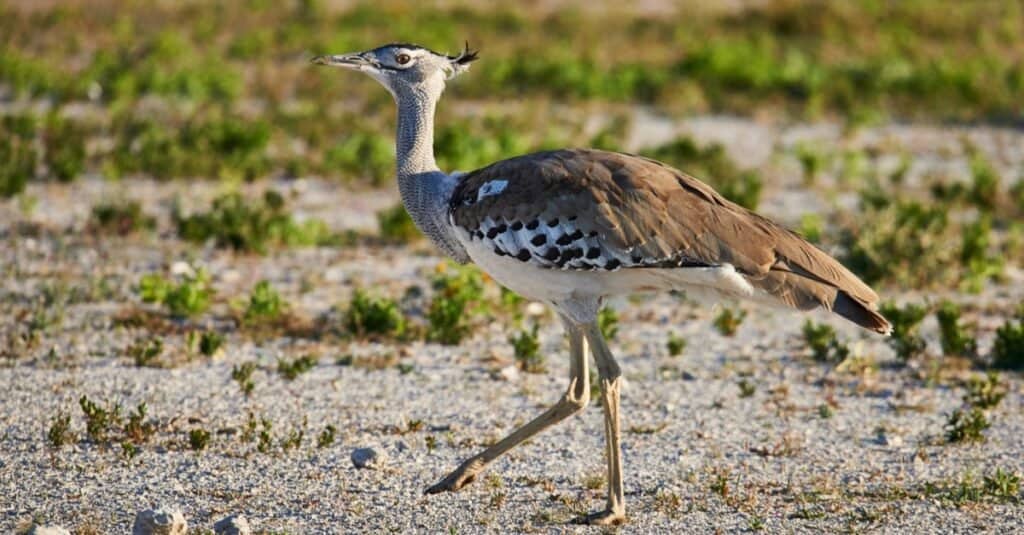
©ArCaLu/Shutterstock.com
This African bird weighs up to 42 pounds as an adult. Though it’s at home on a list of big birds that fly, they prefer to walk or run around their savannah habitat. They have gray and white feathers, long legs, and a pointed beak.
Some of the different types of big birds on this list are here for more than one reason. The Kori bustard has tremendous height as well as a heavy weight. Adult males can reach a height of five feet.
#6 Darwin’s Rhea

.
©RudiErnst/Shutterstock.com
The Darwin’s Rhea is one of two types of large birds on this list that live in Peru, Chile, Bolivia, and elsewhere in South America. They are found in grassland or scrub habitats. The Darwin’s Rhea usually weighs around 55 pounds but can weigh up to 63 pounds as adults. Though it doesn’t qualify as one of those big birds that fly, Darwin’s rhea can run at speeds of around 37mph. Not bad!
This bird has a thick layer of spotted brown and white feathers. Its long legs and neck make it look a little like an ostrich. Darwin’s rhea has sharp claws it uses as a defense against predators.
#5 Domesticated Turkey

©iStock.com/DA69
This bird’s fan of black and brown tail feathers tipped with white makes them easily recognizable. Also, domesticated turkeys have a bright red wattle below their beak paired with a bright red snood on top of their beak.
Domesticated turkeys are seen in many areas around the world but descend from turkeys that originated in the central part of Mexico.
These turkeys can weigh up to 86 pounds. So, the question arises: Can domesticated turkeys fly? Though some wild turkeys can fly, domesticated turkeys don’t qualify for the big birds that fly list. Most are too heavy to get their bodies off the ground.
#4 Emperor Penguin
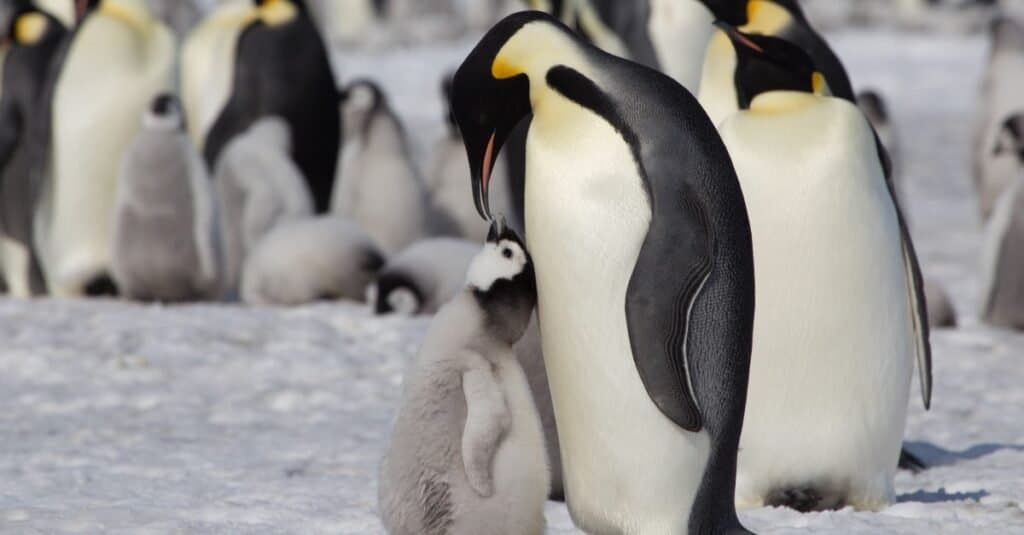
©robert mcgillivray/Shutterstock.com
Emperor penguins live in Antarctica just as king penguins do. When looking at different types of big birds belonging to the Spheniscidae (penguin) family, the emperor penguin holds the title as the largest member. It stands to reason with a name like the emperor penguin.
Emperor penguins weigh up to 99 pounds. They are also the tallest at 51 inches. They have black feathers on their back and white on their chest stomach. This bird has bright yellowish/orange feathers around its throat. Male and female emperor penguins look a lot alike.
#3 Emu
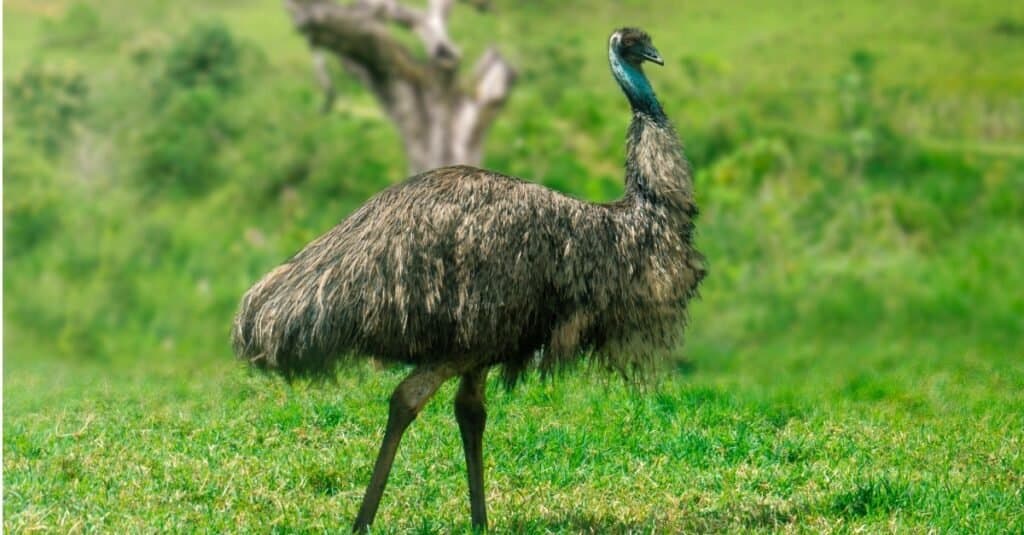
©iStock.com/Gilnature
This large bird has a combination of brown, gray, and black feathers. Furthermore, it has long legs with three toes on each foot. Emus weigh up to 132 pounds so it should come as no surprise that they are not fliers. But they can run at a speed of 30mph through the Australian desert plains.
An emu has incredibly strong legs which makes it dangerous to anything that threatens it or its young. It has a powerful kick along with sharp claws that can cause injury. Some emus stand a little over six feet tall which is definitely enough to scare some of its predators away.
#2 Southern Cassowary

©Kensho Photographic/Shutterstock.com
The southern cassowary is another large bird from Australia. The first thing you notice about a southern cassowary is its bright blue head. The second thing you notice is the horn on the top of its head. This is known as a casque. It has bright red wattles just under its blue head along with thick black feathers on the rest of its body. Females are larger than males weighing around 167 pounds. Males weigh around 120 pounds.
While southern cassowaries don’t take flight, they do walk, swim, and run with ease. The claws on their feet make it easy to move through the debris in their tropical forest habitat.
One of the most interesting things about this bird is it lays three to five bright green eggs. But, it seems appropriate for such a colorful bird to have colorful eggs as well.
#1 Common Ostrich
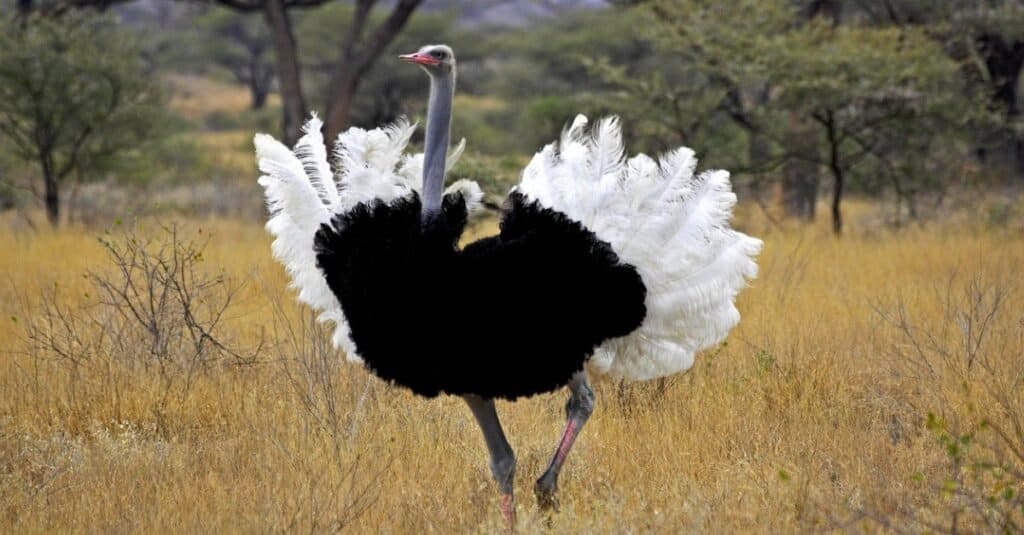
©iStock.com/slowmotiongli
Out of all of the types of large birds, the ostrich is the biggest one worldwide. Picture two adult, average size men and you have a weight equal to the weight of this bird. Specifically, the common ostrich weighs about 320 pounds. But there are male ostriches on record that weigh 346 pounds. As if that’s not enough to get them the number one spot on a list featuring different types of big birds, these feathered creatures are tall. A male common ostrich can grow to a height of a little over nine feet! Females reach a height of just under seven feet.
Common ostriches are from Africa. Their soft, fluffy feathers range from dark brown to black with a gathering of off-white tail feathers. This bird’s long legs and clawed feet allow it to reach a speed of 43mph. In addition to running, they also use their legs and clawed feet to lash out at predators. Their feet are made to withstand the tough, desert terrain they walk and run on without getting injured.
You’ve probably already guessed that a bird of this height and size, keeps its feet planted firmly on the ground. However, it does make use of its wings in another way. It unfolds them as it runs as a way to maintain balance.
Up Next…
Keep reading these posts for more incredible information about key animal facts.
- The Top 9 Largest Flying Birds in the World: Their ability to take to the skies belies their size. Read about these 9 gravity defying avians right here.
- The Top 10 Fastest Birds in the World: If there were an Avian Olympics, they’d be the top contenders. Find out just how fast they can go.
- The Top 10 Highest Flying Birds in the World: These birds take their head for heights to unprecedented levels. Find out which species they are and just how high they’re capable of soaring.
The photo featured at the top of this post is © Sergei25/Shutterstock.com
Thank you for reading! Have some feedback for us? Contact the AZ Animals editorial team.







